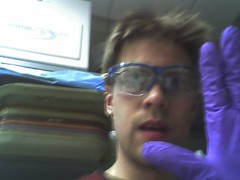Robot Arms and the Force Fields Who Love Them
When I last discussed what I actually do at my new job, I sort of intended to pick up the dropped ball rather soon. Like... when I got up from my nap. Or Tuesday night. That'll show me, I guess.
So the first thing I'll need to do is show you my favorite part of my new job: the manipulandum.

That's the one in our lab, randomly found online. So why is the manipulandum so awesome?
Because it's a robot arm that simulates force fields. I will never fail to entertain at parties so long as I can mingle with a glass of wine in one hand and say, "I work with force fields generated by robot arms."
Chick MAGNET, I tell you. Try it yourself some time.
Now that I'm done with my geekgasm; the robot arm is connected to a computer that we can program boundaries into. Within or around those boundaries (depending on the configuration), the user can explore the workspace with relative impunity. But when they connect with a boundary, the robot arm opposes their movement. This simulates a force field in that location. The user can then explore this boundary by moving the manipulandum against those areas where it resists their movement.
Generally, manipulandum experiments are done while the subject is blindfolded to prevent them from utilizing visual input about their hand location in determining what the boundary 'looks' like. Why is the person above not blindfolded? Obviously, she's cheating.
Just kidding. Manipulandums (manipulandi?) can also be used for motor learning experiments, and probably other things I haven't even bothered to think of yet. Check the page the image came from, if you're curious.
So what can the manipulandum tell us? From the papers I've read so far, there seem to be two main categories. The first is data about the exploration process. When a subject is exploring a certain type of boundary, do they move more quickly or more slowly? Do they run past certain parts more times than others? How much force do they apply at each point?
The second is data from replication. In our lab, depending on what we're working on, there are two main ways people can replicate an image. The first is with the manipulandum itself. After someone feels they have explored a boundary enough, we can turn off the force fields and allow them to "sketch out" the shape they perceived with their handle. There are some problems with this, though: how much of the sketch is due to the picture they've synthesized through haptic exploration, and how much of it is just a replay of motor memory? And since they can't see what they're drawing with the manipulandum, how much of the error in the sketch is due to errors in the initial perception, and how much of it is an error in skill at reproduction? To comparatively answer these questions, we also have a touchscreen display. Some subject can use this to draw the shapes directly onto a monitor. Since this requires a shift in both facing orientation and in the plane of reproduction, this should prevent the subjects from reproducing an image entirely from motor memory. Also, subjects can decide whether or not an image looks appropriately like what they sensed and decide whether or not to keep it. The main problem with this technique is it also allows for confounding of error by introducing visual distortions on top of haptic distortions.
We can then compare the data drawn on the touchscreen to the data reproduced on the manipulandum to determine how faithfully people can reproduce and how faithfully they can perceive the forms presented to them by the manipulandum. We can also compare this to the data taken by the manipulandum during exploration to find out what techniques lead to higher haptic acuity, and what types of data impact a subject's accuracy in haptic perception. Does exploring in a certain direction improve haptic acuity? In a certain part of the workspace? Are people more reliant on changes in speed or force, or do they take either of these measures into account at all?
These are the sorts of basic questions that had to be answered before more complicated ones could be covered. And in the next section, I'll get to a few of those and cover some of the papers I had to spend the first half of the week obsessing over.


1 Comments:
ultra boost
pandora jewelry
issey miyake
ralph lauren outlet
coach outlet online
adidas outlet
cheap oakley sunglasses
mulberry handbags
ralph lauren outlet
Post a Comment
Send Haloscan trackback ping
<< Home